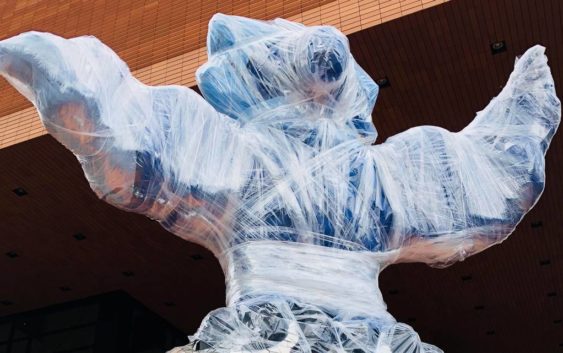- Seven months after Hurricane Helene, Chimney Rock rebuilds with resilience
- Wildfire in New Jersey Pine Barrens expected to grow before it’s contained, officials say
- Storm damage forces recovery efforts in Lancaster, Chester counties
- Evacuation orders lifted as fast-moving New Jersey wildfire burns
- Heartbreak for NC resident as wildfire reduces lifetime home to ashes
Uptown’s most iconic sculpture has a new look as it prepares for Hurricane Florence

In the face of ferocious winds that could pelt it with flying debris, French-American artist Niki de Saint Phalle’s “Firebird” — the 18-foot-tall uptown sculpture covered with about 7,000 pieces of mirrored glass — might as well be a sitting duck.
And so on Thursday morning, the Bechtler Museum of Modern Art took steps to safeguard the rather fragile artwork from the possible effects of Hurricane Florence this weekend: It wrapped up the top portion of the sculpture (that’d be the actual bird; the lower part consists of an arch the bird perches on) so that it looks as if it’s ready to be loaded into the back of a moving truck.
The bird was covered with a protective material akin to moving blankets, then it was wrapped in a thick plastic sheeting. Then those two layers were secured in place by cling film, which is kind of like a very sturdy Saran wrap.
Why only the bird and not the arch, which is clearly made with glass as well?
Because the colored mirrored-glass tiles on the bird itself are not as easily replaced as the tiles on the arch, says Christopher Lawing, the Bechtler’s executive vice president. The tiles on the bird, it turns out, are from a company in France that is no longer in operation.
Meanwhile, the tiles on the arch are just “regular mirrored glass,” Lawing says. “And (the base) was deliberately designed that way by Niki de Saint Phalle for it to be repaired over time, because it was always meant to be a public piece.”
In fact, he says, the arch undergoes minor repairs two or three times a year to address general wear and tear. The bird itself has never been damaged.
The temporary covering, of course, gives the photogenic sculpture an even more unique appearance than usual, so Lawing says passersby have continued to take pictures of the “Firebird” just as much as usual. And he says that its hurricane-ready look might also be serving as a helpful reminder.
“I think covering it up … makes people feel like the storm is gonna be more impactful than I think they at first had realized, if we’re taking this sort of care to protect something that is so widely known. So maybe it’s also a call for people to take this threat pretty seriously.”